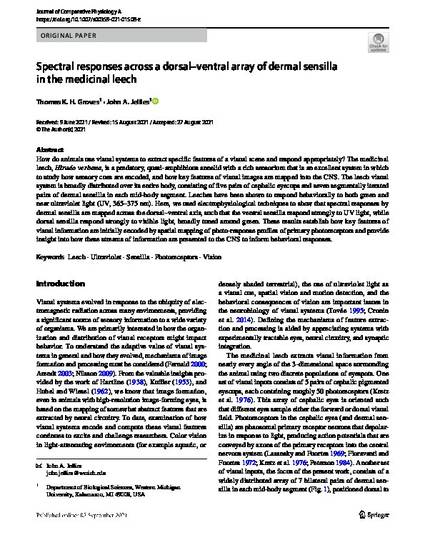
Article
Spectral responses across a dorsal–ventral array of dermal sensilla in the medicinal leech
Journal of Comparative Physiology A
(2021)
Abstract
How do animals use visual systems to extract specific features of a visual scene and respond appropriately? The medicinal leech, Hirudo verbana, is a predatory, quasi-amphibious annelid with a rich sensorium that is an excellent system in which to study how sensory cues are encoded, and how key features of visual images are mapped into the CNS. The leech visual system is broadly distributed over its entire body, consisting of five pairs of cephalic eyecups and seven segmentally iterated pairs of dermal sensilla in each mid-body segment. Leeches have been shown to respond behaviorally to both green and near ultraviolet light (UV, 365–375 nm). Here, we used electrophysiological techniques to show that spectral responses by dermal sensilla are mapped across the dorsal–ventral axis, such that the ventral sensilla respond strongly to UV light, while dorsal sensilla respond strongly to visible light, broadly tuned around green. These results establish how key features of visual information are initially encoded by spatial mapping of photo-response profiles of primary photoreceptors and provide insight into how these streams of information are presented to the CNS to inform behavioral responses.
Keywords
- Leech,
- Ultraviolet,
- Sensilla,
- Photoreceptors,
- Vision
Disciplines
Publication Date
Fall September 3, 2021
DOI
https://doi.org/10.1007/s00359-021-01508-z
Citation Information
Groves, T.K.H., Jellies, J.A. Spectral responses across a dorsal–ventral array of dermal sensilla in the medicinal leech. J Comp Physiol A (2021). https://doi.org/10.1007/s00359-021-01508-z
Creative Commons license

This work is licensed under a Creative Commons CC_BY International License.
